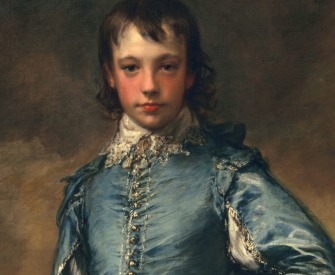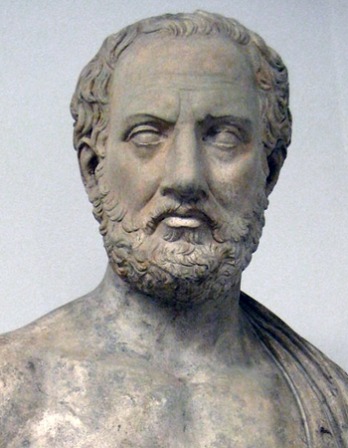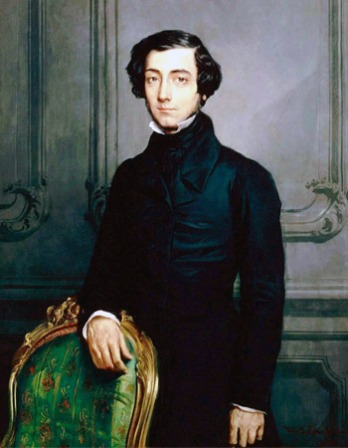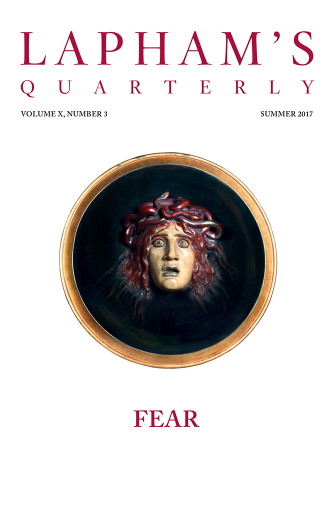Love is so short, forgetting is so long.
—Pablo Neruda, 1924Affairs of State
How the improbable marriage of an actress, courtesan, and daughter of an animal trainer to a Byzantine emperor dramatically changed the course of European history.
By William Rosen

Empress Theodora and retinue, mosaic panel from the Basilica of San Vitale, Ravenna, Italy, sixth century.
The best examples of counterfactual history display two characteristics. The first is equal plausibility for both the actual historical event and its alternative. The other is impact: the alternative must be consequential. This explains the popularity of military history in the world of the counterfactual; battles are refought incessantly, both by professional soldiers studying their intricacies and by historians wondering about the long tail of consequences had the Persians defeated the Spartans at Thermopylae, or if Robert E. Lee had flanked George Meade at Gettysburg and headed for Washington. Counterfactuals can also cover scientific discoveries: even though they always seem inevitable in retrospect, where and when they are made certainly matters. Imagine, for example, if Hitler had been free of anti-Semitism, and therefore disinclined to chase Europe’s best physicists into the embrace of the Manhattan Project, or the historical repercussions if twelfth-century China had acquired steam power. The path of history can even be rerouted by a single bullet: perhaps the most famous is the one used by Gavrilo Princip to kill Archduke Franz Ferdinand in Sarajevo, setting in motion the events that led to World War I. Histories turn on epidemics, earthquakes, and, of course, elections. The U.S. presidential election was thrown into the hands of the Supreme Court by a margin of no more than a thousand ballots cast in Florida—probably fewer than the number of voters whose cars broke down on their way to the polls.
And then there’s love. Any particular courtship may be plausible, but its outcome is always unforeseeable: Cupid is blind for a reason. Sometimes a romance starts in the bedroom and ends on the battlefield; dowries and dynastic claims alone are responsible for enough wars, assassinations, and conquests to fill a month on the History Channel. When the Infanta Catherine of Braganza was betrothed to Charles II, her trousseau included deeds to the cities of Tangier and Bombay, laying the foundation for the British control of India. The 1677 marriage of William of Orange to Catherine’s niece Mary led, eleven years later, to the offer of the English throne, an end to five decades of civil war, and what has come to be known as the Glorious Revolution. Even more significant are the most frequent (and predictable) consequences of sex: children. In James Goldman’s play The Lion in Winter, Eleanor of Aquitaine, the onetime wife to Louis VII of France, reminds her sons by her second husband, Henry II of England, “Good, good Louis. If I’d managed sons for him instead of all those little girls, I’d still be stuck with being Queen of France, and we should not have known one another. Such, my angels, is the role of sex in history.” It played a starring role, in this case, since two of those sons—Richard the Lion-hearted, the leader of the Third Crusade, and John Lackland, reluctant signer of the Magna Carta—were among the more consequential monarchs in English history.
But while kings and queens may come to love, and even lust, after one another, their unions are usually motivated by a more cold-blooded calculus. The ideal erotic counterfactual wouldn’t depend upon the union of two dynastic houses, nor would its world-historical impact be its progeny. The couple would have chosen one another, rather than be chosen for one another. The historical record of the marriage would include an event in which two possible outcomes appear in stark relief: one in which the couple married, and one in which they did not. And the event would be so well documented that we could even name the day on which it occurred.
On Sunday, January 18, 532, the sun rose fairly late over Constantinople—had one been available, a modern watch would have read 7:29 a.m.—but no one in the world’s most populous city saw it through the smoke. The city, which had been the center of the Roman Empire ever since Constantine had founded it as his eponymous capital two centuries before, was on fire. Five days earlier, what had begun in the city’s chariot-racing stadium as a protest against two planned hangings had turned into the biggest civil insurrection in the empire’s history. Tens of thousands of rioters had vandalized and burned the imperial senate, the city’s most important church, the enormous public Baths of Zeuxippus, and dozens of other buildings. By Sunday, the riot had escalated into a rebellion. The insurgents demanded the abdication of the current emperor, whose own bodyguards had him and his empress besieged in their own palace.
The trapped ruler had traveled a long and indirect route to the pinnacle of the empire founded by Augustus six centuries before. Christened Flavius Petrus Sabbatius in the last years of the fifth century, he had come to Constantinople as the protégé of his uncle, a successful officer in the palace guard. There, he took advantage of the capital’s substantial educational opportunities and his own even more substantial intelligence to place his uncle on the imperial throne, and to succeed him, under the name he gave himself: Justinian.
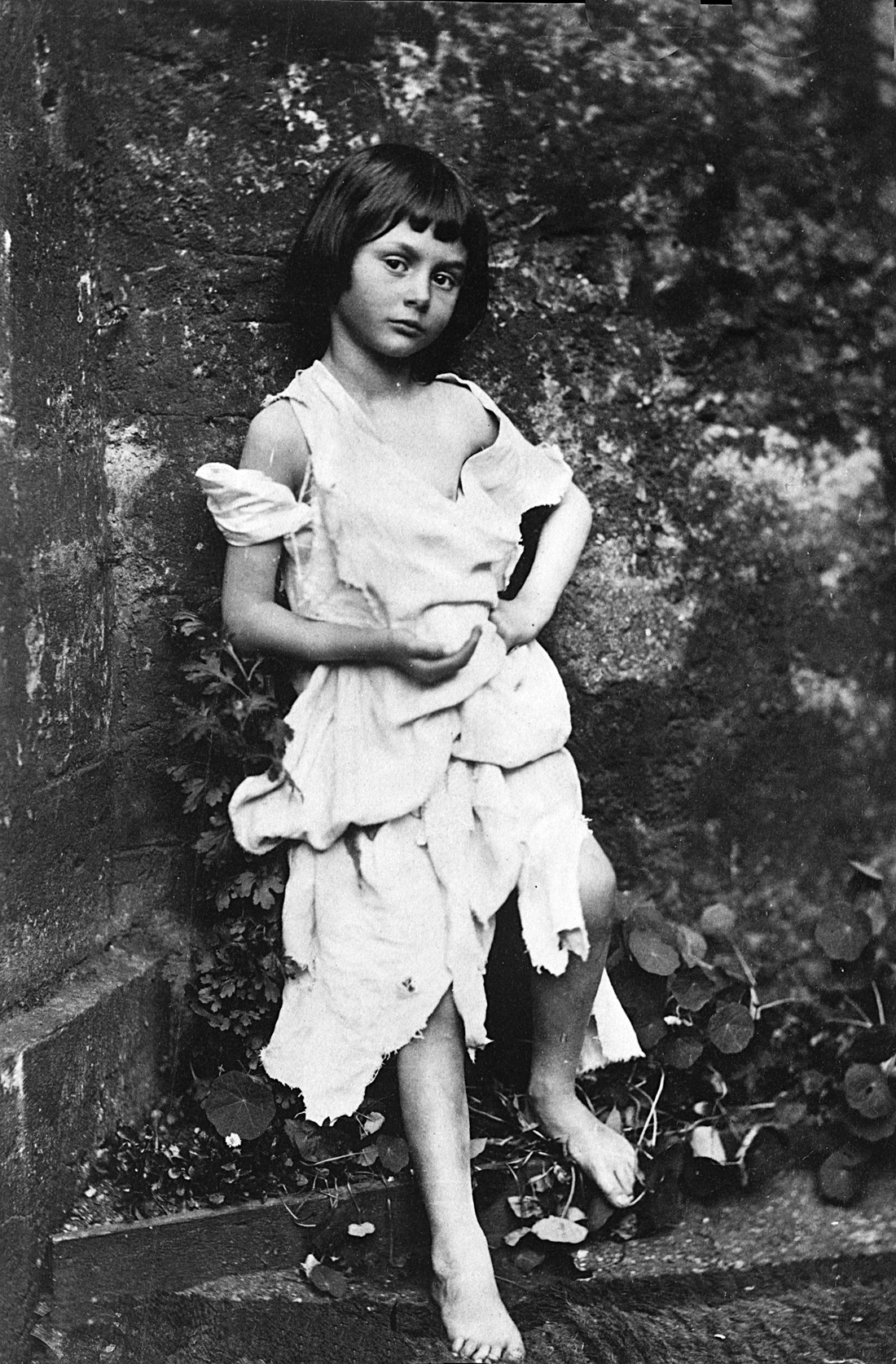
Alice Liddell as “The Beggar Maid,” c. 1859. Photograph by Lewis Carroll.
He was already first in line for the crown when he met his future empress, Theodora, whose path to the palace was even more improbable than Justinian’s own. His father was a Balkan peasant; hers was an animal trainer for Constantinople’s circuses. He had spent his early years as a student of theological dogma and an undistinguished soldier. She had been a high-priced prostitute and Constantinople’s most famous erotic actress: a petite, wavy-haired beauty with enormous dark eyes and a stage act that was three parts Mae West, two parts Jenna Jameson. It strains credulity to imagine that the balding, strait-laced, paranoid, brilliant-but-dull Justinian and the beautiful, notorious Theodora even met, much less fell in love. No record exists of their first meeting in 522, but since one of the few things they shared was enthusiasm for the same chariot-racing team, a reasonable guess is that they met at some social function associated with it. Although, to be sure, calling the “Blues” a racing team seriously understates its importance; in sixth-century Constantinople, racing teams were a combination of political party, entertainment conglomerate, and social welfare organization. However the two met, it must have been something of a thunderbolt, since they were living together within weeks, pleading for Justinian’s uncle, the emperor, to amend an old law that prohibited imperial officials from marrying actresses. They were Late Antiquity’s most unlikely couple, the sixth-century equivalent of Marilyn Monroe as Richard Nixon’s First Lady.
And even at that, their falling in love seems more plausible than their staying in love. The pair was forced to wait three years before marrying—Justinian successfully changed the law but had trouble persuading his aunt that Theodora was future empress material, and their nuptials had to await her death. But once they were wed, they stayed married, ’til death they did part. The best evidence for their enduring mutual affection is that while both endured vitriolic libels, smears, and defamations—Justinian’s own court historian wrote that “the emperor was not a man, but… a demon in human shape,” and that “unseen powers could not allow any spot on earth to be unaware of Theodora’s depravity”—not one word suggests that either was ever unfaithful to the other. With no surviving children, they were passionate only about politics and each other. Theodora, one imagines, was attracted to Justinian’s power and intellect. The qualities that seduced Justinian were presumably Theodora’s beauty, easily seen in the only surviving contemporaneous image of her—the mosaics in the Church of San Vitale in Ravenna—and her intelligence, which was “superior to all the world” in the words of one contemporary. Most important to history if not to Justinian, however, was her courage.
Which brings us back to that Sunday morning in Constantinople in 532. With his city burning around him and his palace guards worse than useless, Justinian’s nerve cracked. He prepared to escape to Greece with as much gold as he could, leaving the throne to the rioters’ favorite, Hypatius, a nobleman related to a former emperor. All his advisers agreed, with a single exception: Theodora, who announced, in no uncertain terms, that she would rather die as an empress than live as a commoner. Justinian, his spine newly stiffened, decided he would rather risk dying with Theodora than living alone. He ordered a roll-of-the-dice attack on the rioters that broke the back of the rebellion, executed Hypatius, and saved his throne, which he would hold for another thirty-three years.
Had Justinian, who was already heir to the throne, not met Theodora in 522, he would certainly still have become emperor. If they had never married, the riots, known to history as the Nika riots for the rallying cry of the insurgents—nika, or “victory”—would still have occurred. And if Theodora had not been present on that January day, Justinian would have become yet another entry in the depressingly long list of Roman emperors deposed by fractious mobs. The world-historical impact of the courtship of Justinian and Theodora, therefore, hangs on the size of the footprint left by Justinian after 532.
A list of the high points of Justinian’s reign after 532 is a long one. He completely restored Constantinople after the riots, and built the granaries and cisterns that made the city essentially siege-proof for the next nine centuries. He commissioned dozens of architectural masterpieces, including the Hagia Sophia, which was built to replace the church destroyed in the riots. He reconquered Italy, North Africa, and a good bit of Spain: longtime imperial territories which were in 532 under the respective control of Ostrogoth, Vandal, and Visigoth kings. Finally, he held the eastern borders of the empire against the encroachments of the Sassanid Persians. All of these footprints, and a hundred more, can be traced to the courtship of Justinian and Theodora. All changed the world to some degree, though ranking them depends in part upon the observer’s preferences. Is the creation of the Hagia Sophia, an architectural masterpiece that still evokes awe fifteen centuries after it was built (in a remarkably brief six years) a more enduring achievement than the destruction of the Ostrogothic Kingdom of Italy? Perhaps; but Justinian’s Italian wars, and the destruction they left behind, led directly to the invasions of the peninsula by both Lombards and Franks, and indirectly, to the founding of the city of Venice as a protective enclave from the northern invaders. And if it seems overreaching to trace the founding of Venice to the marriage of Justinian and Theodora, consider that Justinian’s conquest of Italy established a vassal state of Constantinople, the Exarchate of Ravenna, which the Carolingian Franks granted to the pope in 757 to establish the great temporal power known as the Papal States throughout the Middle Ages.
The courage of the empress permitted the emperor to leave another footprint, as long-lasting as the Hagia Sophia, and even more consequential than the wars: the complete codification of Roman law, eventually titled the Corpus Juris Civilis, or Body of Civil Law, and familiarly known as the Justinianic Code. By the time of the Nika riots, the project of cleaning up eight centuries of contradictory legislation, judicial interpretations, and imperial decrees dating back to the days of the Roman Republic had only recently gotten underway. The emperor had assembled a commission consisting of virtually every important legal scholar and jurist in the empire to produce a “single Code which shall bear our own name” and handpicked a senior minister, Tribonian, to manage them. Two years after Theodora saved her husband from the ignominy of abdication, the commission delivered to Justinian more than a million words in three volumes that comprise, like the King James Bible, that rarest of works: a masterpiece produced by a committee. The legal historian Alessandro Passerin d’Entrèves makes the comparison explicit: “It is no exaggeration to say that, next to the Bible, no book has left a deeper mark on the history of mankind.”
Or, at least, on the history of Europe. For while the English-speaking world—Britain and her former colonies—remain loyal to that hodgepodge of custom, history, and precedent known as the common law, the legal systems of continental Europe derive from an entirely different tradition: the civil law, whose founding document is the Code of Justinian. Long after Justinian’s empire had devolved into a state that was sovereign over little more than the city of Constantinople, millions of people living in onetime Roman territories were still adjudicating torts, punishing criminals, and probating wills using his Code.
The central idea of the Code, evoked throughout the history of civil law, remains Quod principi placuit, legis habet vigorem: “The will of the prince has the force of law.”
As a result, the nations that adopted the civil law proved far more congenial to tyrannical regimes than those using the common law; it is no accident that the Magna Carta, the Petition of Right, and the U.S. Constitution have no analogs in civil law nations whose legal superstructure was built on the Justinianic Code. Neither the Inquisition nor the Enlightenment, nor the French Revolution nor the Third Reich can be understood without reference to the Corpus Juris Civilis. Justinian left the European nations that grew out of Roman soil more than just the law; he bequeathed them autocracy as well.
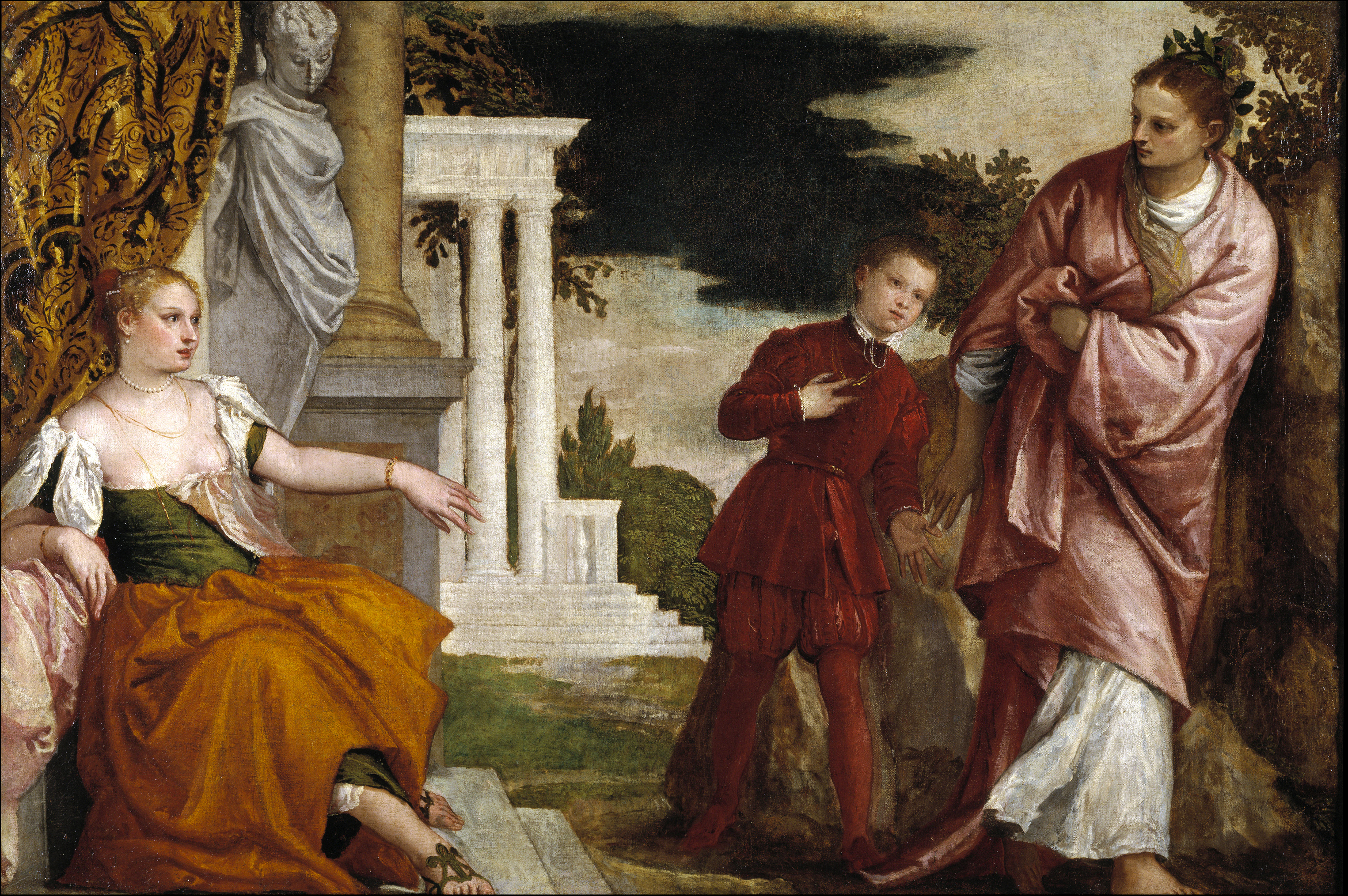
Youth Between Vice and Virtue, by Paolo Veronese, c. 1581. Prado Museum, Madrid, Spain.
But the bequest took a long time to be claimed. As Justinian’s empire contracted in the face of the Islamic invasions that began in the seventh century, the Code itself was lost, and for nearly five centuries, the legal systems of Europe and Britain evolved in the same haphazard and syncretric way, drawing on everything from canon law to local precedent to ancient Visigothic justice. Not until the eleventh century was a surviving copy of the Code of Justinian rediscovered—rather improbably, in a monastery in the Italian city of Pisa—copied, and transferred to the great medieval university in Bologna. From there, the idea of granting ultimate authority to the “will of the prince” spread throughout what would become Italy, Spain, Germany, and France, stopping only at the English Channel, where the messy development of the common law continued unimpeded. We know Justinian’s Code would have remained unwritten had its architect departed Constantinople on that January day in 532. We can legitimately assume that, without it, the European legal tradition would far more closely resemble Britain’s. We can only wonder whether Common Law protections against arbitrary state action—the writ of habeas corpus, for example—would have been a durable barrier to despotism in a Europe that never knew the Code of Justinian, but we can be certain that the Continent would have been quite different than the one we know.
The conquest of Italy and North Africa, the construction of one of the world’s greatest churches, and the compilation of Europe’s most enduring legal code are a lot of weight to place on a single marriage. Nonetheless, it is impossible to imagine any of them without Theodora’s presence at Justinian’s side during the Nika riots, which makes the meeting of the onetime courtesan and the ambitious Balkan peasant the most consequential first date in history. Though no reliable information exists concerning Justinian and Theodora’s introduction (or, for that matter, their wedding), such is not the case with their farewell. On June 28, 548, Theodora died, most likely of cancer. For days, the animal trainer’s daughter lay in state in the imperial palace, dressed in purple on a gold catafalque. The people filing past in review included not only the city’s patriarch, senators, priests, and the leading members of every aristocratic family in Constantinople, but also dozens of former prostitutes and actresses who had been housed and clothed by the empress who had never forgotten them. On the day of the funeral, the last procession Theodora would lead advanced slowly to another of Justinian’s architectural marvels: the Church of the Holy Apostles—Constantine’s burial site, and the model for Venice’s San Marco—where the empress was interred in an enormous sarcophagus of Sardian stone in plain view of Justinian, who broke down in tears. One observer wrote that “the old man no longer cared for anything; his spirit was in heaven.” The emperor would live for another seventeen years, consolidating his imperial acquisitions, building his cities, and plotting against his adversaries. He owes his legacy, however, to the sixteen years between the Nika riots and Theodora’s death: between the day his lover saved him and the day she left him forever.
